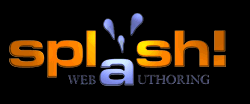













Forms are useful for transmitting data back to you, some of the best uses are for comments, feedback, guestbooks and just general data. Forms are made up of a number of objects that help define the information that can be inputed or even selected.
Form details is used to set up your CGI-Script. Note that you must have a CGI-Script in order to use forms.
CGI-Script URL
This defines the location of the actual CGI-Script to be used. The CGI-Script will interpret all the information sent to it.Use Default Splash Script
This will allow to use our CGI-Script.Note: Only for registered Splash! users.
Method To Submit
This will define how the information is sent to the CGI-Script. There are two methods, and the method used will depend on the CGI-Script used. If you are using the default CGI-Script, you may use either method.A Get will send the information as part of the URL and is generally used to request information. A Post will send the information within the document itself, and is generally used to send information.
This object allows the browser to accept text input via the keyboard. Such fields are usually used for things like inputing a name or even for typing a password. The following variables help define how this is acheived.
Size of Entry Window
This defines the amount of characters to be displayed inside the string.Variable Name
How the CGI Script from the form details is going to identify this field.Initial Value
If you would like a default string or number, this will tell the browser and Splash! to have this variable displayed inside the field, upon loading the page.Maximum Length of String
This is used to set the number of characters to be input. Setting this field to 10 will only allow 10 characters to be inputed. This value will default to 255.Set as Password field
As described above, this field can be used as a password field. What this means is that whatever you type will be echoed back as an *.This is used to give choices to the viewer. They can then choose options via the checkbox. The only settings needed for a checkbox is its name, which tells any scripts how to identify the object. The other setting required tells the browser if it should default as being checked or not.
A Radio field is identical (in terms of functionality) to a Checkbox, only it offers a different way of displaying the objects. A radio field is a circle based object, whereas a CheckBox is simply, a box. There is however one extra setting for a radio field. This is its value. What this allows you to do, is have a group of radio buttons called Age, and give each button a seperate Value for each age-group. Hence, you can have multiple choices for each category. For more information on radio buttons, try our tutorials!
The textarea field is similar in functionality as the Text/Password object. The difference being that a textarea allows more lines to be displayed, but does not have a password option.
Variable Name
How the CGI Script from the form details will identify this field.Number of Rows:
This will tell Splash! how many rows are to be displayed in the textarea. Setting this value to 5 will display 5 rows.Number of Cols:
This tells Splash!, how many characters can be displayed per row. If you want to have it display 40 characters accross, then set this field to 40.This object places a button on the page that can be controlled in two ways. This is determined by the method to submit option below.
Variable Name
How the CGI Script from the form details will identify this field.Button Name
When placing a button down on the page, this option will give the button a name. This is so that we can identify it later.Method to Submit
There are two options here. You can place a submit button, or a reset button. When placing a submit button down, it allows people to have their data submitted to, and processed by, the CGI-Script defined in Form Details. The reset button will reset the form to it's original state so that people can re-enter their information into the form.Hidden fields are good to keep certain data invisible to the user. It is commonly used for CGI-Scripts.